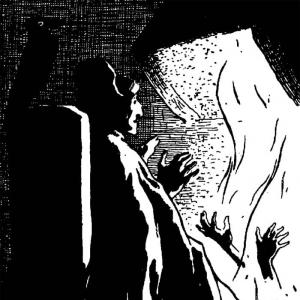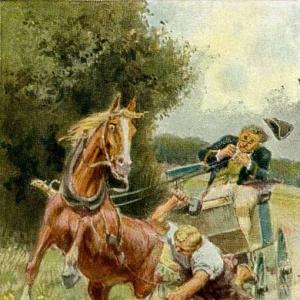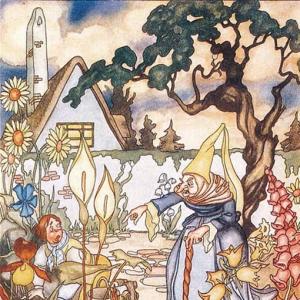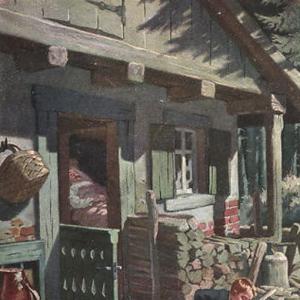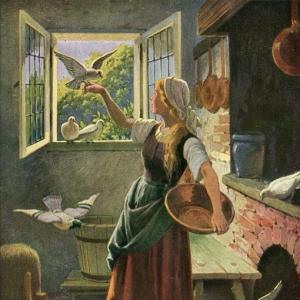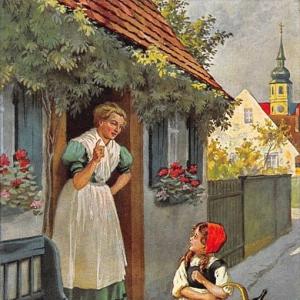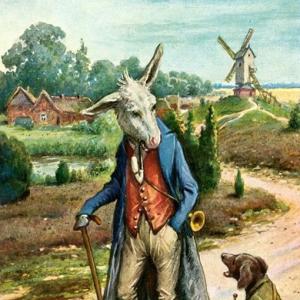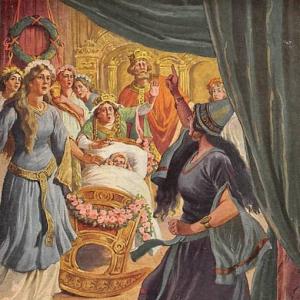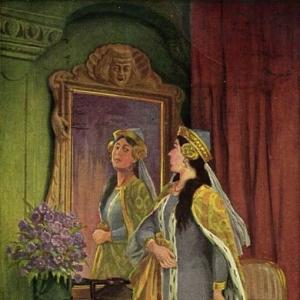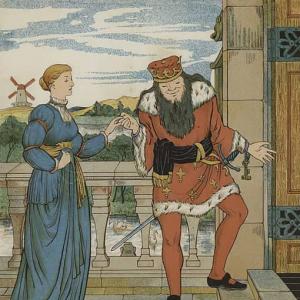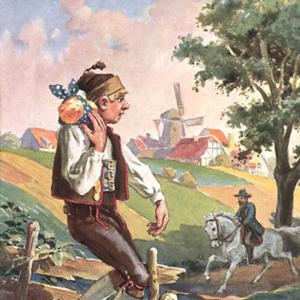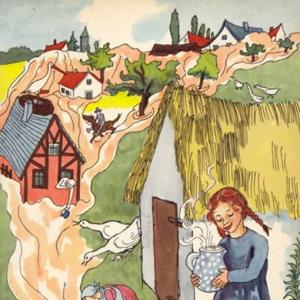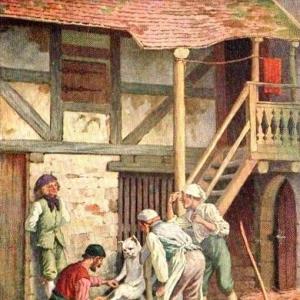Reading time: 8 min
A poor servant-girl was once travelling with the family with which she was in service, through a great forest, and when they were in the midst of it, robbers came out of the thicket, and murdered all they found. All perished together except the girl, who had jumped out of the carriage in a fright, and hidden herself behind a tree. When the robbers had gone away with their booty, she came out and beheld the great disaster. Then she began to weep bitterly, and said, „What can a poor girl like me do now? I do not know how to get out of the forest, no human being lives in it, so I must certainly starve.“ She walked about and looked for a road, but could find none. When it was evening she seated herself under a tree, gave herself into God’s keeping, and resolved to sit waiting there and not go away, let what might happen. When, however, she had sat there for a while, a white dove came flying to her with a little golden key in its mouth. It put the little key in her hand, and said, „Dost thou see that great tree, therein is a little lock, it opens with the tiny key, and there thou wilt find food enough, and suffer no more hunger.“ Then she went to the tree and opened it, and found milk in a little dish, and white bread to break into it, so that she could eat her fill. When she was satisfied, she said, „It is now the time when the hens at home go to roost, I am so tired I could go to bed too.“ Then the dove flew to her again, and brought another golden key in its bill, and said, „Open that tree there, and thou willt find a bed.“ So she opened it, and found a beautiful white bed, and she prayed God to protect her during the night, and lay down and slept. In the morning the dove came for the third time, and again brought a little key, and said, „Open that tree there, and thou wilt find clothes.“ And when she opened it, she found garments beset with gold and with jewels, more splendid than those of any king’s daughter. So she lived there for some time, and the dove came every day and provided her with all she needed, and it was a quiet good life. Once, however, the dove came and said, „Wilt thou do something for my sake?“ – „With all my heart,“ said the girl. Then said the little dove, „I will guide thee to a small house; enter it, and inside it, an old woman will be sitting by the fire and will say, ‚Good-day.‘ But on thy life give her no answer, let her do what she will, but pass by her on the right side; further on, there is a door, which open, and thou wilt enter into a room where a quantity of rings of all kinds are lying, amongst which are some magnificent ones with shining stones; leave them, however, where they are, and seek out a plain one, which must likewise be amongst them, and bring it here to me as quickly as thou canst.“ The girl went to the little house, and came to the door. There sat an old woman who stared when she saw her, and said, „Good-day my child.“ The girl gave her no answer, and opened the door. „Whither away,“ cried the old woman, and seized her by the gown, and wanted to hold her fast, saying, „That is my house. No one can go in there if I choose not to allow it.“ But the girl was silent, got away from her, and went straight into the room. Now there lay on the table an enormous quantity of rings, which gleamed and glittered before her eyes. She turned them over and looked for the plain one, but could not find it. While she was seeking, she saw the old woman and how she was stealing away, and wanting to get off with a bird-cage which she had in her hand. So she went after her and took the cage out of her hand, and when she raised it up and looked into it, a bird was inside which had the plain ring in its bill. Then she took the ring, and ran quite joyously home with it, and thought the little white dove would come and get the ring, but it did not. Then she leant against a tree and determined to wait for the dove, and, as she thus stood, it seemed just as if the tree was soft and pliant, and was letting its branches down. And suddenly the branches twined around her, and were two arms, and when she looked round, the tree was a handsome man, who embraced and kissed her heartily, and said, „Thou hast delivered me from the power of the old woman, who is a wicked witch. She had changed me into a tree, and every day for two hours I was a white dove, and so long as she possessed the ring I could not regain my human form.“ Then his servants and his horses, who had likewise been changed into trees, were freed from the enchantment also, and stood beside him. And he led them forth to his kingdom, for he was a King’s son, and they married, and lived happily.
 Learn languages. Double-tap on a word.Learn languages in context with Childstories.org and Deepl.com.
Learn languages. Double-tap on a word.Learn languages in context with Childstories.org and Deepl.com.Backgrounds
Interpretations
Adaptions
Summary
Linguistics
„The Old Woman in the Wood“ is a German fairy tale collected by the Brothers Grimm, Jacob and Wilhelm, in their famous book „Grimms‘ Fairy Tales“ (originally titled „Children’s and Household Tales“ or „Kinder- und Hausmärchen“ in German). The collection was first published in 1812 and went through several revisions and expansions, with the final edition being published in 1857.
The Brothers Grimm were German academics, linguists, and cultural researchers who collected and published a vast number of folktales from various regions, intending to preserve the cultural heritage and oral traditions of the German-speaking people. Many of their collected tales have since become famous worldwide, including „Cinderella,“ „Snow White,“ „Hansel and Gretel,“ and „Rapunzel.“
„The Old Woman in the Wood“ is not as widely known as some of the other Grimm stories, but it shares some common themes and motifs with other fairy tales, such as the transformative power of love, the importance of inner strength and resilience, and the idea of breaking enchantments or curses.
The story also reflects elements of the broader European folklore tradition, including the recurring motif of helpful animals or magical creatures guiding and assisting the protagonist in their journey. Moreover, the tale highlights the significance of folk wisdom and moral values, such as faith, kindness, and determination, in overcoming adversity and achieving personal growth.
„The Old Woman in the Wood“ can be interpreted in various ways, with key themes and messages embedded in the story:
Faith and resilience: The servant-girl’s faith in God and her determination to survive, despite the dire situation she finds herself in, demonstrate the importance of resilience and belief in overcoming adversity.
The power of kindness and gratitude: The girl’s willingness to help the white dove, even though she doesn’t know what the consequences will be, emphasizes the importance of kindness and gratitude. Her kindness is rewarded when the prince is freed from the enchantment.
The danger of superficiality: The girl is tasked with finding a plain ring among a collection of valuable, shiny rings. This can be interpreted as a metaphor for recognizing true value and beauty beyond outward appearances. The plain ring is the key to breaking the enchantment, showing that sometimes the most ordinary-looking things can have the most significant impact.
The importance of inner strength and wisdom: The girl’s ability to resist the old woman’s attempts to distract and manipulate her highlights the importance of staying true to one’s values and focusing on the task at hand. This message underscores the significance of inner strength and wisdom in overcoming obstacles and achieving one’s goals.
Transformation and redemption: The story conveys the idea of transformation and redemption, as the enchanted prince is freed from the witch’s curse, and the servant-girl’s life changes dramatically when she marries the prince. This theme reflects the idea that positive change and growth are possible, even in the most challenging circumstances.
Overall, „The Old Woman in the Wood“ presents a tale of resilience, faith, kindness, and the power of inner strength to overcome obstacles and bring about positive change.
„The Old Woman in the Wood“ is a classic fairy tale that has inspired numerous adaptations in various forms of media. Here are a few notable adaptations:
„Hansel and Gretel“ (1893): This famous opera by Engelbert Humperdinck is based on the Grimm brothers‘ version of „The Old Woman in the Wood“. It tells the story of two siblings who get lost in the woods and encounter a witch who tries to eat them. The opera has become a classic in its own right and has been adapted into many different versions over the years.
„Hansel and Gretel“ (1937): This animated film by Walt Disney Productions is a loose adaptation of both „The Old Woman in the Wood“ and „Hansel and Gretel“. It tells the story of two children who get lost in the woods and encounter a witch who wants to eat them. The film is notable for its use of music and memorable characters, including the wicked witch.
„The Juniper Tree“ (1986): This film by Nietzchka Keene is a dark and haunting adaptation of „The Old Woman in the Wood“. It tells the story of a young girl who is murdered by her stepmother and is reincarnated as a bird. The film is notable for its eerie atmosphere and unconventional storytelling.
„Into the Woods“ (1987): This musical by Stephen Sondheim and James Lapine is a modern take on several classic fairy tales, including „The Old Woman in the Wood“. It tells the story of a baker and his wife who go on a quest to reverse a curse that has left them childless. Along the way, they encounter characters from various fairy tales, including Little Red Riding Hood and the Witch.
„Grimm Tales for Young and Old“ (2012): This collection of short stories by Philip Pullman includes a retelling of „The Old Woman in the Wood“. Pullman’s version is faithful to the original story but adds his own unique voice and perspective. The collection has been praised for its literary quality and its ability to capture the timeless appeal of the Grimm brothers‘ tales.
„The Old Woman in the Wood“ is a Brothers Grimm fairy tale that follows the story of a poor servant-girl who survives a robbery in the forest that results in the death of her employers. Lost and alone, she prays for help and is aided by a white dove who provides her with food, shelter, and clothes through the use of golden keys that unlock trees containing these provisions.
One day, the dove asks the girl for a favor in return: to enter a small house occupied by an old woman and retrieve a plain ring among many other valuable ones. The girl complies, ignoring the old woman’s attempts to engage her in conversation and stop her from entering the house. She finds the old woman trying to sneak away with a birdcage containing the desired ring and retrieves it.
Expecting the dove to take the ring, the girl waits by a tree. The tree then transforms into a handsome man who reveals that he was under the spell of the old woman, a wicked witch. The girl’s actions broke the enchantment on the man, his servants, and his horses, who had all been turned into trees. The man, a prince, takes the girl to his kingdom, and they marry and live happily ever after.
Linguistic analysis of „The Old Woman in the Wood“ by the Brothers Grimm can be approached from several perspectives, focusing on elements such as narrative structure, thematic motifs, language style, and character development. Here are some insights based on a linguistic and literary analysis:
Narrative Structure: The fairy tale follows a classic structure of conflict, journey, and resolution. The initial conflict arises when the servant-girl is left alone after a robbery, setting her off on a quest for survival and eventual rescue. The structure includes a series of three repetitive tasks involving the dove, typical of fairy tales, where tasks are often grouped in threes, building a rhythmic narrative progression.
Language and Style: The language is simple and direct, characteristic of oral storytelling traditions. The straightforward prose helps convey the magical and moral themes to a broad audience, including children. The use of archaic language and second-person singular pronouns like „thou“ and „wilt“ adds an old-world, fairy-tale charm and authenticity.
Symbolism and Motifs
Forest: The forest symbolizes the unknown and is a common setting in fairy tales representing both danger and mystery.
Dove: Traditionally a symbol of peace and providence, the dove acts as a guardian and helper, providing the girl with keys to her needs and guiding her actions.
Keys and Locks: These symbolize secrecy and discovery. Each golden key opens a new part of the girl’s journey toward freedom and self-sufficiency.
Rings: They often symbolize eternity and unity. In this tale, the plain ring represents truth and the power to break enchantments, contrasting with the more elaborate, yet deceptive, rings.
Themes
Transformation and Liberation: Central to the tale is the theme of transformation—both literal (the prince and his servants from trees back to human form) and metaphorical (the servant-girl’s growth from a helpless state to one of agency and empowerment).
Good vs. Evil: As in many fairy tales, characters are divided into clear moral categories. The old woman embodies evil (witch-like characteristics), while the dove and the prince symbolize goodness and justice.
Providence and Faith: The girl’s reliance on divine providence („gave herself into God’s keeping“) depicts a moral lesson of faith and trust that help will come at the right time.
Character Development: The servant-girl starts as a passive character, victim to circumstances beyond her control. Her development is highlighted by her interaction with the dove and the tasks she undertakes, culminating in her being the agent of change for the prince. The old woman, though a minor character, serves as a classic antagonist, embodying the threats and trials the protagonist must overcome.
Use of Supernatural Elements: The tale heavily relies on supernatural elements typical of the Brothers Grimm, like enchanted trees, talking birds, and metamorphosis, which not only create a magical atmosphere but also facilitate narrative progression.
Overall, „The Old Woman in the Wood“ is rich with the motifs, structure, and themes common in fairy tales, using simple yet evocative language to weave a story about transformation, courage, and the triumph of good over evil.
Information for scientific analysis
Fairy tale statistics | Value |
|---|---|
| Number | KHM 123 |
| Aarne-Thompson-Uther-Index | ATU Typ 442 |
| Translations | DE, EN, DA, ES, PT, HU, IT, JA, NL, PL, RU, TR, VI, ZH |
| Readability Index by Björnsson | 33.9 |
| Flesch-Reading-Ease Index | 79.5 |
| Flesch–Kincaid Grade-Level | 8.5 |
| Gunning Fog Index | 11.6 |
| Coleman–Liau Index | 6.9 |
| SMOG Index | 8.6 |
| Automated Readability Index | 9.6 |
| Character Count | 4.655 |
| Letter Count | 3.557 |
| Sentence Count | 36 |
| Word Count | 921 |
| Average Words per Sentence | 25,58 |
| Words with more than 6 letters | 77 |
| Percentage of long words | 8.4% |
| Number of Syllables | 1.104 |
| Average Syllables per Word | 1,20 |
| Words with three Syllables | 32 |
| Percentage Words with three Syllables | 3.5% |

 Facebook
Facebook  Whatsapp
Whatsapp  Messenger
Messenger  Telegram
Telegram Reddit
Reddit
